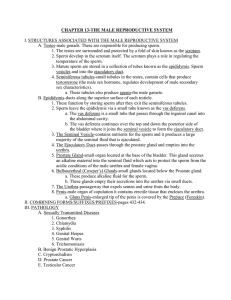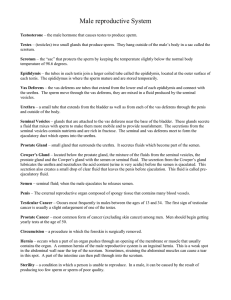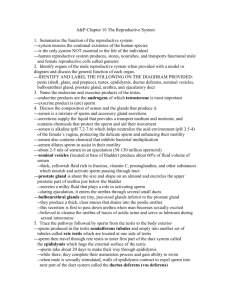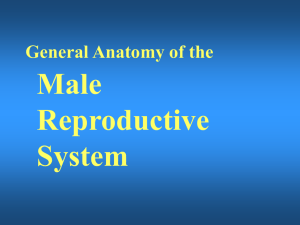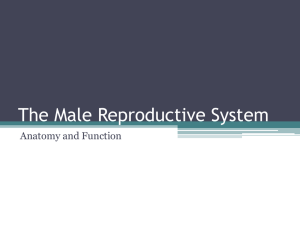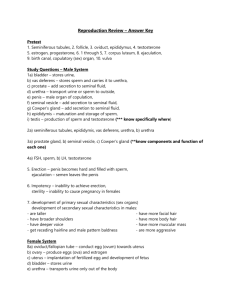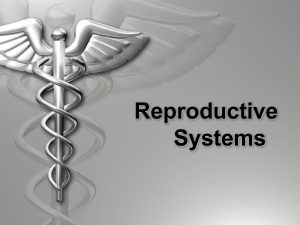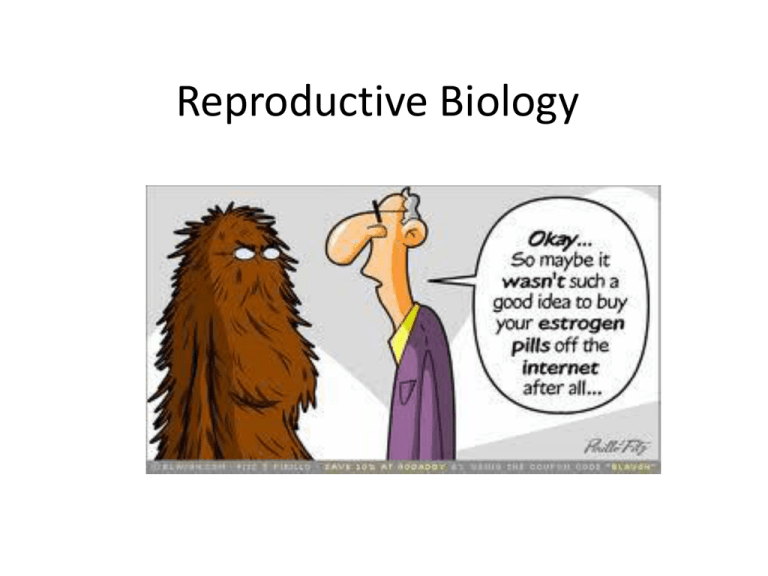
Reproductive Biology
I. Need for Meiosis
• A. Human
chromosome
number = 46
• B. Mitosis
• C. Meiosis
• 1. purpose
• 2. location
• 3. difference in male
and female meiosis
II. Male parts
A. Testes
• 1. produces sperm
in seminiferous
tubule
• 2. approximately
700 feet long
• 3. site of male
meiosis
• 4. interstitial cells
also located in testes
• 5. producers of
testosterone
B. Epididymis
• 1. location
• 2. 20 feet
• 3. twenty days to pass
through
• 4. undergo maturation
• 5. storage organ
• 6. contracts upon
ejaculation sending
sperm on to next part
of journey
C. Vas deferens or ductus deferens
1. Travels from epididymis to
urethra
2. Travels through the
inguinal canal with the
spermatic cord-blood
vessels and nerves
3. Expands into the ampulla
4. Then enters ejaculatory
duct
5. Vasectomy
a. Part of vas lies in
scrotum
b. Local
c. Small incision
d. Cuts and ligates
e. Sterile but not
impotent
D. Urethra
1. Prostatic urethra
2. Membranous
urethra
3. Spongy or penile
urethra
4. Carries both sperm
and urine
5. Never at same time
E. Accessory glands producing semen
1. seminal vesicles
a. Produce 60% of
semen
b. Thick yellowish
secretion
c. Rich in sugar, vitamin
C, and prostaglandins
d. Nourish and activate
sperm
e. Joins vas deferens on
either side to form
ejaculatory duct
2. Prostate gland
a. Doughnut shaped
b. Size of peach pit
c. Milky alkaline fluid
that activates sperm
d. Approximately 40% of
semen
e. Anterior to rectum is
able to be palpated by
digital exam
f. Hypertrophy
3. Bulbourethral glands
a. Also called Cowper’s
glands
b. Base of prostate-size of
peas
c. First to empty with
ejaculation
d. Cleanse and neutralizes
penile urethra
e. Also minor lubricant for
coitus
4. Seminal fluid
a.
b.
c.
d.
e.
f.
g.
Mature sperm are streamlined missiles
Need nutrient source-fructose from seminal vesicle
Need buffer from prostate
Prostaglandins cause smooth muscle to contract
Fibrinogen and profibrinolysin
Inhibitors of female immune system
Dilutes sperm
F. Male parts
• 1. scrotum
•
a. Air conditioner
•
b. Rather exposed
•
c. Cooler temperatures
•
d. Best produced 93 degrees
•
e. Bikers’ problems
2. Penis
a.
b.
c.
d.
e.
f.
Corpora cavernosa
Corpus spongiosum
Urethra
Glans penis
Prepuce
Mechanics of an erection
G. Spermatogenesis
• 1. occurs in
seminiferous tubule
• 2. spermatozoa
• a. acrosome
• b. head
• c. midpiece
• d. flagella
3. Defective sperm and numbers
a.
b.
c.
d.
e.
f.
Defective morphology
Low sperm count
10 million/ml
Varicocoel
Cryptochordism
Retrograde ejaculation
H. Testosterone production
1. Interstitial cells of Leydig
2. In response to LH production
by the anterior pituitary
3. Occurs at about the age of 12
4. Maturation of male
reproductive parts
5. Stimulates production of
sperm along with FSH
6. Produces male secondary
sexual traits such as hair
growth patterns, deepening of
the voice, skeletal muscle
development
III. Female parts
A. Ovary
1. ovarian follicles
2. oocyte and
follicular cells
3. antrum with
follicular fluid
4. Graafian follicle
5. ovulation
6. corupus luteum
B. Duct system
1. Fallopian tubes
2. Fimbriae
3. Uterus
a. Body, fundus, cervix
b. Endometrium, myometrium
4. Vagina-birth canal
C. Female external genitalia
1.
2.
3.
4.
5.
6.
Mons pubis
Labia majora
Labia minora
Vestibule
Clitoris
Perineum
IV. Female reproductive functions
A.
1.
2.
3.
4.
5.
Oogenesis
Oogonium
Primary oocyte
Meiosis I
ovulation
Meiosis II
B. Hormonal interactions
1. Pituitary
hormones
2. Ovarian events
3. Ovarian hormone
fluctuations
4. Uterine lining
evernts
And then there was baby
• http://www.evtv1.com/player.aspx?itemnum=
735
Fetal development
• http://www.youtube.com/watch?v=RS1ti23SU
Sw


